With only a handful of flamingos sighted at the usually-crowded Sewri mudflats at this time of the year, is the worst fear of birders questioning the Mumbai Trans Harbour Link already coming true?
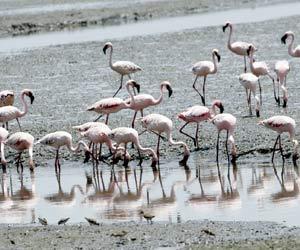
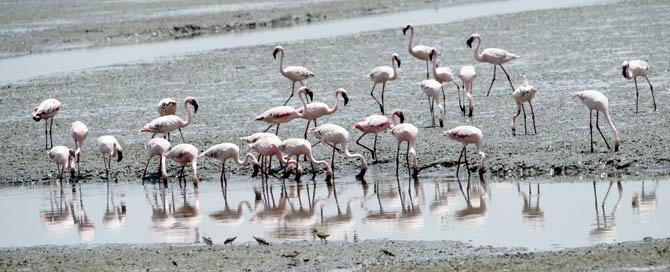
A photograph of flamingos at Sewri last year when the population observed was higher
Pradip Patade can't put a number to his observation. But, the 50-year-old who runs the Marine Life of Mumbai page on Facebook and conducts weekly walks to acquaint Mumbaikars with the thriving life on our coastline says that in the last few weeks the population seen at the Sewri mudflats has been far fewer than what's considered normal. In fact, Patade, a former human resource professional, says he has been coming to Sewri as an avid birder for the last 10 years and this is the first time that the population of the pink birds that have made the creek the most popular winter destination in Mumbai among nature lovers, has dropped. That the site will, by the end of the year, witness immense construction activity for the Mumbai Trans Harbour Link project has also alarmed Mumbai's birders who fear that flamingos, having lost a safe habitat, will fly away from Sewri.
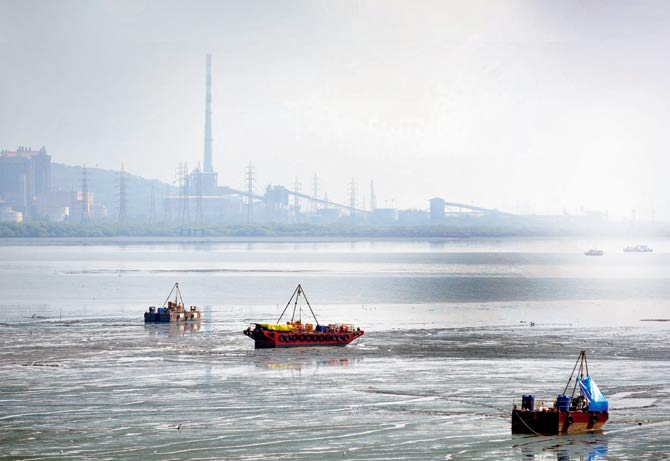
Soil testing units along Sewri where the MTHL is to come up. Patade says the noise pollution these units create can cause damage to, and drive the birds away. Pics/Bipin Kokate
Mumbai's pink hue
The first time that flamingos were spotted in Mumbai was in 1994 along the Thane Creek. No research has been conducted to study why the flamingos, who migrate from Gujarat's Bhuj region every winter and stay here till May, changed their migratory pattern. Until 1994, the flamingos were not known to leave Bhuj. Today, by November, 30,000 of these birds come to Mumbai and return to Gujarat for breeding season. Ninety per cent of the flamingos that come to Mumbai are Lesser Flamingos. Aside from Sewri, they are also seen at Airoli creek mudflats, Bhandup pumping station, Uran, the mudflats along Palm Beach Road in Navi Mumbai and, sometimes at the Gorai-Marve creek.
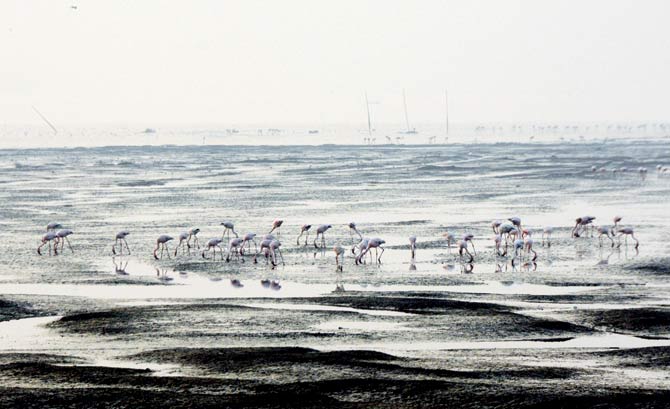
A photograph from last year when the population was much higher
That the birds are still seen at Airoli and Navi Mumbai is an argument that government, and those associated with the project, are making to assure that once the MTHL work is completed, the birds will return to Sewri. MTHL is a 22km-long bridge - 16.5 km of which will cut across the sea - that will provide a direct road connect between Sewri and Nhava Sheva in Raigad, cutting travel time between south Mumbai and Navi Mumbai to just 30 minutes. The link will consist of six lanes (three on either side). The '17,800 crore-project, work on which is expected to begin by November this year, is expected to be completed by 2023, as per current deadlines.
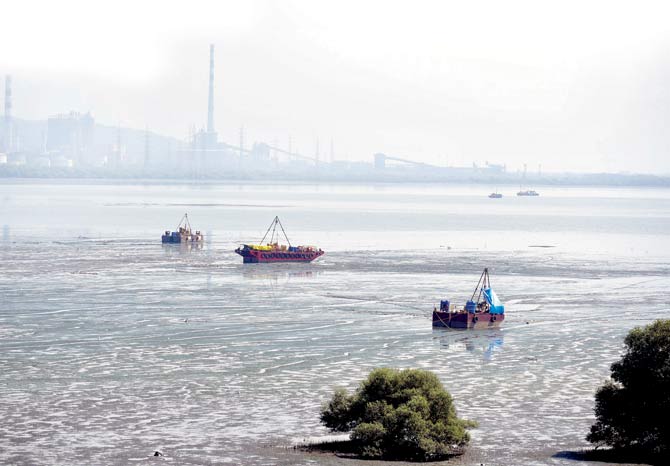
Most birders who've headed to Sewri this year to spot its famous winged visitors have reported a smaller population of flamingos. Pradip Patade, who runs Marine Life of Mumbai, an organisation that acquaints Mumbaikars with the thriving life on our coastline, says the sound pollution caused due to the soil testing activity being conducted for MTHL is driving the birds away. Pic/Bipin Kokate
Deepak Apte, the director at the Bombay Natural History Society (BNHS) which conducted a study to assess the environmental impact of the project on flamingos, says, "There will be disturbance whenever construction begins. But we have a dedicated team which will daily monitor the air and noise impact on the local bird population." He adds that this would not be the first time that massive construction has taken place in flamingo habitats. "Work on the Vashi bridge started in 1987 and was completed in 1997. And the Airoli bridge was constructed in four years and was opened to public in 1999. We have seen the birds return post the construction."
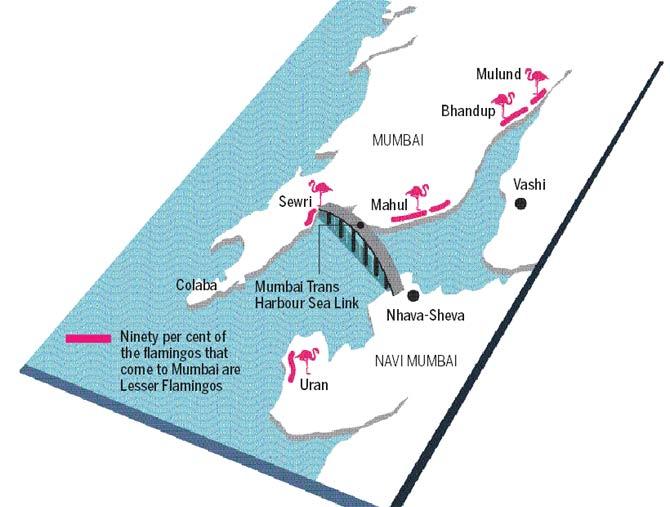
Illustration/Ravi Jadhav
No studies to assess impact
Andheri East resident Akshay Shinde, who has volunteered for various bird surveys conducted by various organisations including the forest department at Sanjay Gandhi National Park (SGNP), says, "Construction of the bridge will be a nuisance to the species which uses a specific aerial route to fly from Uran to Sewri. The probability that the population comes to Sewri but doesn't land due to the disturbance is high. Over a period of time, Thane's Creek will be the only place safe for majority of the colonies and we can expect mass congregation in the creek." It may have already begun. Soil testing for the project, which has begun, is creating sounds of such levels, says Patade, that the birds are flying to Sewri but not landing because they don't sense safety in the habitat.
But, looking at flamingos alone is a narrow view. The Sewri mudflats are an important bird and biodiversity area. Aside from flamingos, a number of threatened species are spotted in the area, including the Egyptian Vulture, River Tern, Painted Stork and Greater Spotted Eagle. Shinde adds, "The eco-system at the Sewri mudflats is going to change gradually. While the flamingos may return, there's no guarantee that the habitat that we leave will be safe for them."
Shinde, who is currently pursuing a master's degree in wildlife from Bhavan's College, says the need of the hour is a study on the migratory pattern of flamingos. "Analysis of heavy metal content should be done in flamingo habitats. Such studies will help us understand how the species will cope with an ever changing city. It will also throw light on how our waste products and industrial effluents will affect them."
Migratory patterns of the species - one of the most basic first steps in conservation - too hasn't been studied. In 2013, BNHS had planned to conduct a study on flamingos and vultures by installing platform terminal transmitters (PTT) on the birds but because of the security concerns raised by the union government - about easy access it would give to spies - permissions were denied. Internationally, birds are radio collared to track their movement which helps in obtaining crucial data of the location and altitude at which the birds fly and also the habitats they prefer. Since this hasn't been done for Mumbai's flamingos, all that is currently known is from data obtained on the shore, which is, therefore, limited.
Damage control plan in place
Among the major fears is that the noise that the construction generates will affect the communication between the birds, impacting their ability to find a mate and socialise with other birds in their community. A study titled The Influence of Anthropogenic Noise on Birds and Bird Studies published by the American Ornithologists Union in Ornithological Monographs in July 2012 reports that noise affects birds in various ways: physical damage to ears; stress responses; fright-flight responses; avoidance responses; changes in other behavioral responses, such as foraging; changes in reproductive success; changes in vocal communication; interference with the ability to hear predators and other important sounds; and potential changes in population. "Some species react more negatively to noise than others. Colonial birds [i.e. birds that nest in colonies] are highly susceptible to noise because when one bird reacts, many or all birds in a colony will react similarly (Burger 1998), whether the group responds."
To mitigate the effects of noise, MMRDA has proposed putting up noise barriers. Dilip Kawatkar, Joint Project Director at MMRDA, and in-charge of MTHL, says they have prepared an environment management plan for the project based on the suggestions made by the Ministry of Environment and Forests. The plan includes mangrove restoration ('25 crore), setting up noise barriers ('45 crore), oil spill mitigation ('10 crore) and conducting monthly bird monitoring ('4 crore). Apte from BNHS says once the construction is completed BNHS will help MMRDA in suggesting mitigating measures. In addition, if, "during construction we feel that better environment- friendly measures need to be taken, we will immediately point them out to MMRDA so that this can be done."
Apte adds, "We will also be studying scientific aspect of how long the birds will take to return to the same spot post construction." Environmentalist Anand Pendharkar from the NGO SPROUTS says there's no reason to fear. He says, a team of over 30 leading researchers and ornithologists surveyed the entire route of the expected impact zone of the MTHL and found that the Flamingo habitat is increasing and there are over one lakh flamingos in the area. The survey team also found that flamingos were easily able to cross over bridges and forage close to boats.
"The birds were also found using the cooling ponds of thermal power plant and other inland protected tidal pools during high tide, with numbers exceeding over 15-16,000. The level of pollution in the creek was a major matter of concern and the level of pollution may, in fact, be a bigger risk for the survival of the migratory birds. If proper scientific and modern methods of drilling are followed the birds may shift temporarily but should return very soon." The question that no one has an answer to, however, is what is the definition of soon?
Noise will affect the birds'...
>> Fright-flight response
>> Reproductive success
>> Ability to hear predators
>> Communication and ability to find mate
The Influence of Anthropogenic Noise on Birds and Bird Studies, published by the American Ornithologists Union in Ornithological Monographs in July 2012
Catch up on all the latest Mumbai news, crime news, current affairs, and also a complete guide on Mumbai from food to things to do and events across the city here. Also download the new mid-day Android and iOS apps to get latest updates
 Subscribe today by clicking the link and stay updated with the latest news!" Click here!
Subscribe today by clicking the link and stay updated with the latest news!" Click here!









